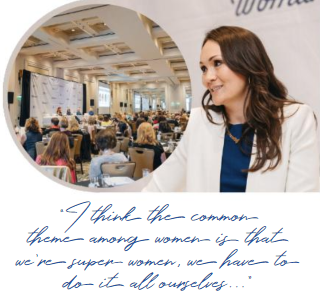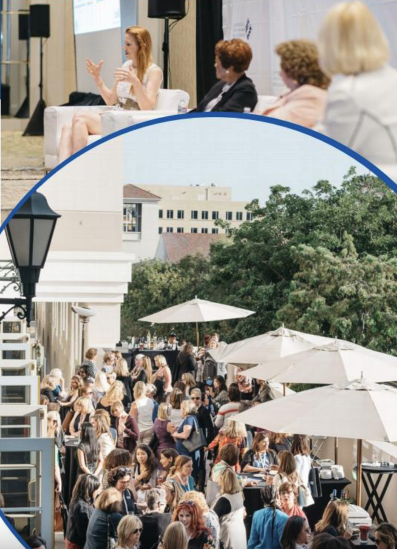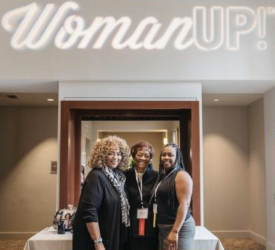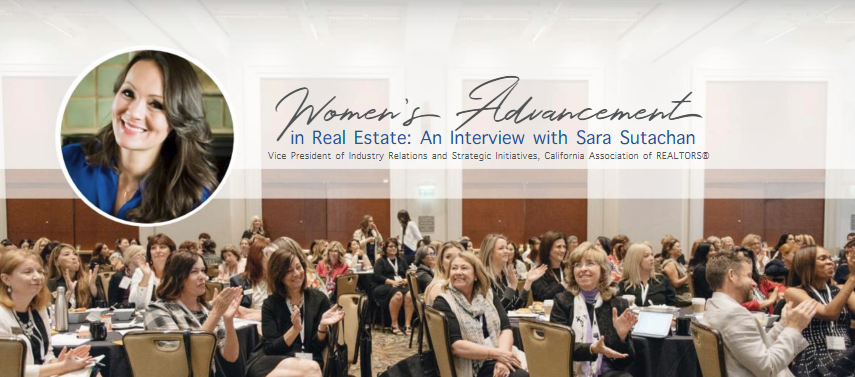What was the inspiration behind WomanUP!? What motivated you to become involved in the women’s movement?
I’ve actually always been a feminist. My mom is a single mom—my dad has always been around—but my mom was a really strong independent woman and she’s my role model. I came to work for the California Association of Realtors® (CAR) and had another amazing role model in Leslie Appleton-Young. I’ve always been attracted to follow strong women, and read books and articles about the women’s movement and the gender gap.

In my role at CAR, I oversee the industry and broker relations, and part of that is interacting and building relationships with the brokerage community and meeting with them on a regular basis. As I met with CEOs and some of the largest brokerage firms in California, I always wanted a balanced room. What I found was that I was hard-pressed to find that balance because the people who led the larger brokerage firms tended to be male.
I’d been noticing this, and even if it wasn’t a large firm, I would make sure women sat at the table. I thought to myself, “This is crazy. We should do something about this.” I couldn’t really drive it home until I got a call from Gretchen Pearson; she was going to speak at a women’s event and said, “I want to know data. Do you have any data on women leaders?” We really didn’t at that point. I had my own personal experience with not finding those women on the rosters, so then we dug into the data. I had my staff look at the largest brokerage firms in California and Google which leaderswere men and which were women. We found that 36 percent of firms were either run by women or had women at the C-level or in management at the top California brokerage firms with over 100 agents. We analyzed a list of approximately 200 of these firms.
I then called my friend Steve Murray who does the Real Trends 500 List, the top 500 firms in the nation. I asked, “What does this look like for you? Which firms are male-led and female-led?” His team did the research for us as well and what they found in 2011 was, 26 percent of the top 500 firms were female-led, but by 2015, that had not changed. That was infuriating.

What we then did was merge Steve Murray’s data, focusing specifically on California, with our data to really look at the top 100 firms based on market share and agent count in order to rank them according to size. I counted the top 100 firms in California myself and found 14 women. If that is not a gap in brokerage leadership, I don’t know what is. That led me to say to Leslie, “This is a problem. We have the data. I want to understand why; how it’s 2017 and we still have this problem.” I also wanted to create a collaborative, safe space and community. I’d been reading all these books on women’s empowerment and women in leadership, including “Own It” by Sallie Krawcheck and “Lean In” by Sheryl Sandberg, and what resonated with me is that women need to support other women, and men, too. You need advocates on your side.
I think the common theme among women is that we’re super women, we have to do it all ourselves, be perfect, and sit and wait our turn. If we can change that in any way by creating this supportive community, highlighting the role models that have done it, and having those women who made it commit to helping other women take the next step in their careers; that’s what the CAR’s Women’s Initiative is all about.
We did a survey of about 1,500 CAR members and asked a series of demographic questions. Fifty-seven percent of our members are women, according to this survey, and when we asked what their role was, only 16 percent of all women said they were broker-owners. We went at this with a strong look at the data that was available: the survey data, brokerage data, and we wanted to couple this with some qualitative data as well. We reached out to 25 female broker-owner in California to do additional interviews.
This year was the first step and next year we’re going to conduct more interviews. We want to find more women role models and leaders to interview, and highlight their expertise and how other women can get in contact with them.
I feel that a lot of this year was about the “Why?” and the next step is about the “How?” How can we help? How do we create this community? How do we help women reach out to other women? That’s really our goal.
It does start with the data; then we have to deliver the tools.
NAWRB is proud to have been part of the C.A.R. WomanUP!™ Conference; the overarching momentum present in the room was compelling. What is the value and necessity of events dedicated to equipping women with tools for professional success?
They are extremely important. Some of the 57 percent female CAR Members may have had an experience where they had an opportunity to step up on their career, maybe they lacked the confidence, thought they couldn’t do it, or didn’t want to. We don’t know the reasons, but what we want to provide is a place where they can ask questions, find their tribe and gain confidence. That’s what it’s all about.
One of the highlights from the WomanUP! Conference was when BerniceLedbetter, a professor at the Pepperdine Center for Women in Leadership, identified confidence as an important skill and assured the audience that if they step out and act as if, their confidence would catch up. I think a lot of us, me included, sometimes lack that confidence. That was so powerful to me. What these events are about is confidence, they are the building blocks helping you feel confident to take the next step.
It goes back to my prior comment. We shouldn’t feel the need to be everything to everybody, we shouldn’t have to be superwoman. We are mothers, family members, wives, widows and we need support. That’s okay. The negative stigma around needing support is unacceptable.
Men have had wives for years and years, and that’s okay, but women can’t have that support? We want to change that perception.
You provided incredible co-panelists that had been realtors for over 50 years and we were able to tell our stories as part of the Overcoming Adversity: What Doesn’t Kill You…Makes you stronger session at the conference. What advice would you like to give to our readers on this topic?
There’s a negative stigma with vulnerability. Brene Brown wrote a book on this topic titled, “Daring Greatly,” which addresses her work and allowing yourself to be vulnerable. I think what the Overcoming Diversity…What Doesn’t Kill You Makes You Stronger Panel at the CAR WomanUP! Conference did was give a stage to three amazing women to share their story, their own personal story. It allowed them to be vulnerable; it was so powerful because it created a camaraderie in the room.
What I’ve known and learned along the way is that I have my own personal story that affects me, and everybody has that. Everybody has their own challenges they’re going through and it’s so nice to feel that you’re not alone.
How can organizations and individuals increase their involvement in movements like WomanUP!?
One of the things that the WomanUP! Conference created was a heightened awareness that a lot of time men, and even women, don’t even notice until somebody brings it up. After that event, I got a Facebook message that was a picture of eight men on a top producer panel for some event. I reached out to that organization and said, “Surely you have women who can fit that mold.” It wasn’t that they considered women and wanted it to be all men, they just weren’t thinking. They were asleep at the wheel, it wasn’t on their radar, so I put it on their radar.

I think what all organizations should do is have balanced panels, balanced rooms, and ask women to be part of their board of directors. Organizations must have that representation because they need diverse voices at the table and on stage. If you’re having an event and have all male speakers, redo that event. If you need to reach out to me, I’ll find women for you.
There is a time and a place to have female-dominated panels, like at the 2017 NAWRB Nexus Conference. It’s purposeful. Let’s say 57 percent of your membership base are women, and you have an event for your entire membership with all male speakers, you have a problem. The stage needs to look like your audience. This not only relates to gender, but also to ethnic background and everything else.
What would you like to see next for WomanUP!? Do you have a particular goal or achievement on the horizon?
What I would like to see next for WomanUP! is to give more time for interaction. We needed to set the stage and tell the “Why?” Now it’s time to hear the voices from the room. Opening up to more interaction and networking opportunities is key to building relationships.
Bottom line, what I would like to see is WomanUP! become broader and have ripple effects throughout the entire industry. I want people to start to listen, realize that there is a gap, and become aware of the people they invite to their panels and speaking events. This is not going to go away and we’re not going to let it go away.
If we can make any impact whatsoever, I’d love to see the gap diminish.
We’re planning to expand the WomanUP! Conference to two days. The first day can have a section devoted to networking. We want to have the audience interact with the panelists. The key feedback from this year’s event was that we didn’t have enough time for interaction. WomanUP! 2018 will take place June 27-28 2018 in Pasadena CA.

 Login
Login

